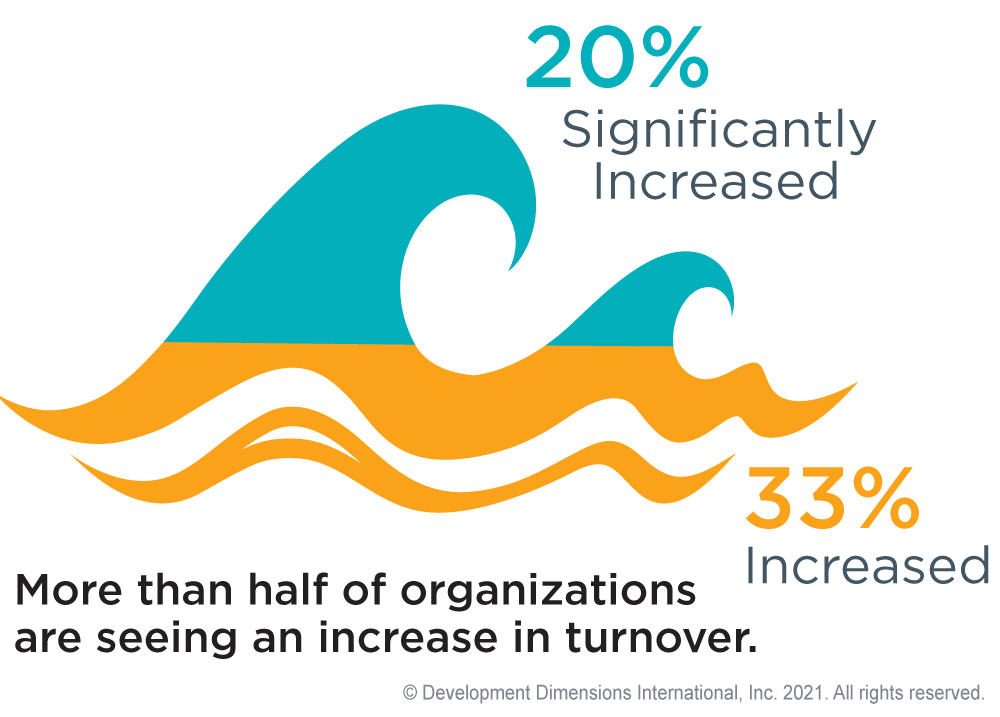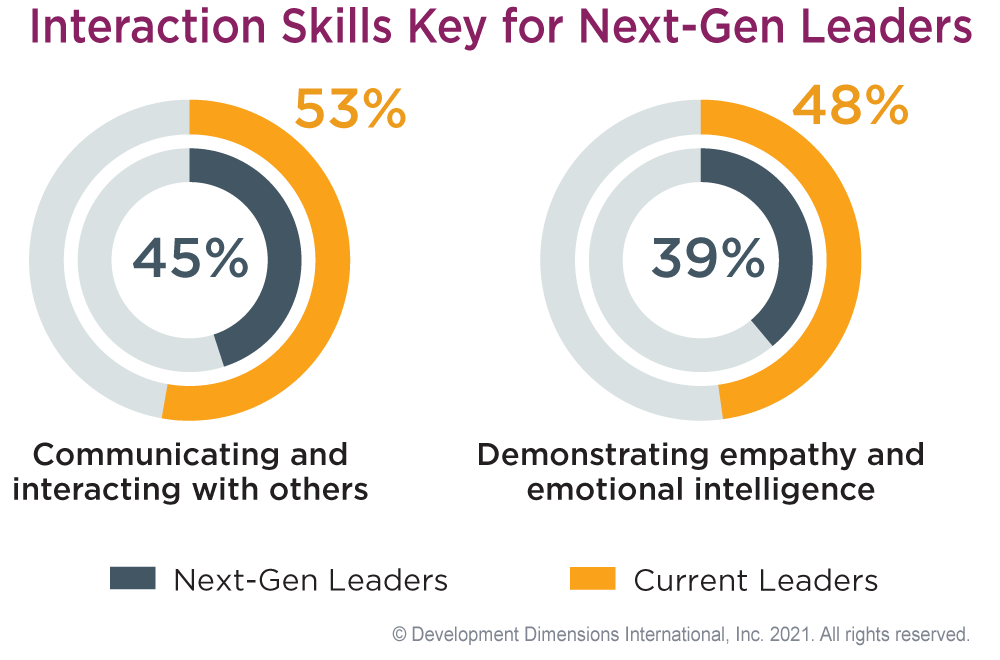With the workforce going through unprecedented changes, new challenges are emerging for companies and leaders to ensure a successful talent pipeline and future. And tumultuous times drive some of the greatest changes, which are now coming to light. Find out what DDI research says are the top leadership trends for 2022 that have come out of these changing times, and what companies can do to respond and make the most of them.
Trend #1: The Race for Top Talent Heats Up
Retaining talent has risen as one of the greatest challenges for organizations following the pandemic. Many employees have re-evaluated what they want out of work as a result of changes over the past year and a half. And the environment for retention has gotten even tougher throughout the Great Resignation.

As part of our Global Leadership Forecast research series, we asked HR executives about the turnover their organizations were experiencing. Before the pandemic, only a third of HR executives indicated they had seen an increase in turnover.
However, we found that the majority are experiencing higher turnover than this time last year. In a recent pulse survey, more than half of HR respondents (53%) reported increasing turnover. Among them, 20% indicated that turnover hadn’t just increased, but it had increased significantly.
The Great Resignation isn’t likely to come to an abrupt end when so much has changed with how and where people work. Instead, with increased flexibility in the workplace, there are increased options for employees and attrition will continue to fluctuate. But what does this mean for organizational knowledge? And how will hiring managers keep up?
These are just some of the questions that companies are grappling with. And these are the questions prompting a different approach for attracting and retaining top talent.
How Organizations Can Stem the Tide of Turnover
In this new environment, companies must do three things to thrive during these times of high turnover, and to attract and retain employees for the future:
1. Instill a sense of purpose.
Recent research from McKinsey showed that in response to the pandemic, nearly two-thirds of employees have paused to reflect on their purpose in life. And nearly half are reconsidering the kind of work they do. For a large majority of professionals (80%), work defines their purpose.
This sense of purpose needs to come from the top, with senior leaders that inspire employees’ confidence. Not only do senior leaders set the tone for a stronger culture, but also greater purpose. With a strong company culture where employees feel they have a sense of purpose, organizations have better employee engagement and retention.
2. Support leadership capabilities to recover.
For companies experiencing higher turnover, having leaders who are effective at delegation, leading virtually, and digital acumen helps with recovery after employees depart. Some roles may not be replaced, and companies will seize the opportunity to automate work where they can. Even with a trend of increased automation, leaders will need to effectively delegate to manage the flow of existing work and resources.
3. Keep employee wellbeing front and center.
A manager’s role in supporting wellbeing will continue to be crucial long after the pandemic. Among companies with leaders who feel they are better prepared to lead virtually, 90% of employees say their manager genuinely cares about their wellbeing. And this is compared to only 79% of employees at other organizations.
This commitment from leaders to employee wellbeing has a big impact on their teams. We found that organizations where managers demonstrate they care about wellbeing are 2.3X better prepared to prevent employee burnout and resulting turnover.
Trend #2: Finding Potential in the (Virtual) Shadows
Any labor shortages in the workforce reverberate up the pipeline. One of the most concerning leadership trends for 2022 coming out of our Global Leadership Forecast series is the shortage of leaders to fill critical roles. Having a strong bench of emerging leaders is necessary to endure well beyond the current turnover challenges.
Although many companies had paused or delayed succession planning efforts over the past year and a half, they are turning back to determine how to best rebuild their talent pools. The shift towards having more remote employees raises new challenges for how companies will surface potential. A hybrid work model offers many benefits including flexibility. However, among the challenges are a reduction in face-to-face time and uneven talent visibility.
This exacerbates what was previously a challenge for many companies. Results in our latest Global Leadership Forecast show that only 51% of companies had an effective process for identifying leadership potential. And that was before many shifted to a hybrid work model, which poses new challenges for identifying high-potential talent.
How Companies Can Surface Potential in the Hybrid Workplace
There are a few ways that companies can better surface potential and increase fairness in a hybrid work environment:
1. Identify and clearly define success profiles.
Defining what success looks like at your company is critical to developing a strong talent pipeline. What are the leadership skills that will drive your company’s current and future strategy? You will need this to identify talent that aligns to your future strategy, but also to develop their capabilities.
2. Surface potential earlier and more broadly.
There’s a broad source of talent waiting to be developed at companies. But in a hybrid workplace, high-potential employees can be trickier to spot. Leverage digital assessments to identify hidden high-potential talent.
3. Develop leaders’ virtual capabilities to build talent.
Across a broad set of leadership skills, leaders reported having the least confidence in their ability to identify and develop talent and lead virtually. Our research shows that few organizations are developing these critical skills in their leaders. Fewer than 30% of leaders said they had received development in these areas, representing a significant opportunity for HR.
Trend #3: Engaging the Next Generation of Leaders
Companies have a well of young leaders ready to grow and progress. They need to build an inclusive workplace environment that encourages talent of all generations to thrive and excel.
New and emerging leaders are looking for more coaching and feedback. Leaders at all levels want feedback, but this next generation of leaders is looking for even more coaching and feedback from their managers.

One in four current leaders said they wanted more coaching and feedback than they are currently getting. But significantly more, one in three next-gen leaders, said this is something they need now. And they are looking for more coaching and feedback in all directions.
Additionally, next-gen leaders are more diverse than any other generation we’ve seen step up in the workplace. Next-gen leaders are also more critical of how their organizations are approaching bias and fairness. Only 56% of next-gen leaders said their leaders challenge themselves and others to recognize and eliminate biases, in comparison to 67% of current leaders.
They are looking for their organizations to do better when it comes to diversity, equity, and inclusion. And this comes through clearly in how they evaluate whether a leader is successful, or a company is a good place to work.
How Organizations Can Attract and Retain Next-Gen Leaders
Given the workplace changes over the past year and a half, there are new stakes for companies to attract and retain the next generation of leaders. Here are three ways to make sure they stay engaged:
1. Focus on flexibility and opportunity for growth.
Create and support flexible work arrangements, including hybrid and fully remote work options. Our research shows one of the major differentiating factors for next-gen leaders as they prepare to step into leadership is when their organizations are doing well with flexible work practices.
In addition, give your up-and-coming leaders developmental assignments to help them grow their skills outside of their day-to-day work. You can also provide them with “stretch” assignments on the job. This will give your high potentials exposure to what they will experience as a leader.
2. Create a culture of inclusion.
Ensure your current and future leaders have the skills needed to create an inclusive environment. These include skills like empathy, coaching for growth, resolving conflict fairly, and more.
Our Diversity & Inclusion Report also revealed the opportunity for companies to leverage three leadership practices that are most predictive of advancing a diverse and inclusive culture. These practices include giving leaders high-quality, personalized development plans, ensuring performance management discussions include a heavy focus on development planning, and building a core leadership program for all leaders in the organization, including high-potential leaders.
3. Provide high-quality development experiences.
Younger leaders especially want to learn together and benefit from being in live learning together. Our research also shows that formal instructor-led training is still a top learning modality for first-time leaders. But you don’t have to be back in person to take advantage of formal classroom training. Virtual classroom is a great alternative to bring new leaders together for a live, face-to-face program.
The Key for Success in 2022
These three leadership trends for 2022 reinforce that having leaders who are more effective and better prepared to meet upcoming challenges will help win the race for talent. It may also determine which companies win in a faster, more tumultuous, and increasingly digital future.
Learn more by attending our webinar, 2022 Forecast: 5 Trends in Leadership.
Stephanie Neal is director of the Center for Analytics and Behavioral Research (CABER). She leads market and trend research focused on leadership and business innovation, and is general manager and lead author of DDI's Global Leadership Forecast.
Topics covered in this blog


